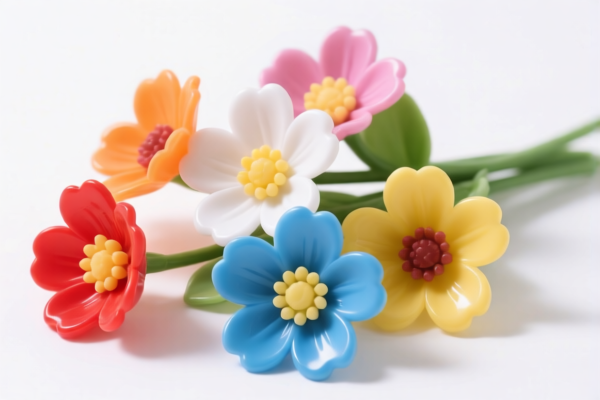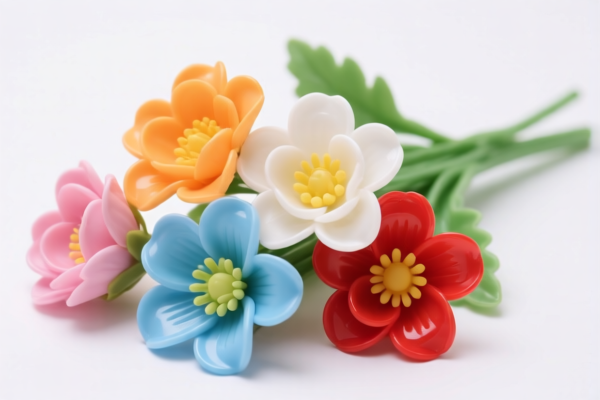| HS Code | Official Doc | Tariff Rate | Origin | Destination | Effective Date |
|---|---|---|---|---|---|
| 1905901041 | Doc | 55.0% | CN | US | 2025-05-12 |
| 1905901050 | Doc | 55.0% | CN | US | 2025-05-12 |
| 6702102000 | Doc | 38.4% | CN | US | 2025-05-12 |
| 6702104000 | Doc | 33.4% | CN | US | 2025-05-12 |




Cake flowers are decorative elements used to embellish cakes, typically crafted from edible materials to resemble blossoms.
Material
The primary materials used in creating cake flowers are:
- Fondant: A pliable, sugar paste that can be molded into intricate shapes and designs. It is the most common material due to its versatility and smooth finish.
- Gum Paste: Similar to fondant but with added gum tragacanth, resulting in a firmer consistency ideal for creating delicate, realistic petals that hold their shape.
- Buttercream: While less structured, buttercream can be piped into floral shapes, often used for softer, more rustic designs.
- Wafer Paper (Rice Paper): Thin sheets of edible paper used for creating lightweight, translucent petals.
- Chocolate: Molded or sculpted chocolate can form the base or details of flowers.
- Icing: Royal icing, when dried, provides a firm base for delicate sugar flower work.
Purpose
Cake flowers serve primarily as aesthetic enhancements. They are used to:
- Decorate Cakes: The most common application, adding visual appeal for celebrations, events, or personal enjoyment.
- Create Floral Arrangements: Multiple flowers can be assembled to form bouquets or cascading designs on cakes.
- Thematic Representation: Flowers can be designed to match specific themes (e.g., roses for Valentine's Day, sunflowers for summer).
Function
While decorative, cake flowers also contribute to the overall presentation:
- Visual Focus: They often serve as the focal point of a cake design.
- Texture and Dimension: Add depth and interest to a flat surface.
- Edible Component: Most cake flowers are fully edible, though some may contain non-edible elements (e.g., floral wire for support, which should be removed before consumption).
Usage Scenarios
- Wedding Cakes: Elaborate sugar flower arrangements are a staple of wedding cake designs.
- Birthday Cakes: Flowers can be customized to reflect the recipient’s favorite blooms or colors.
- Special Occasions: Anniversaries, graduations, baby showers, and other events.
- Professional Baking: Used by cake decorators to create high-end, customized cakes.
- Home Baking: Increasingly popular as a hobby and for personal cake decorating projects.
Common Types
- Roses: The most popular and versatile sugar flower, available in various sizes and colors.
- Peonies: Known for their large, ruffled petals and romantic appearance.
- Hydrangeas: Create full, voluminous arrangements with clusters of small florets.
- Sunflowers: Bold and cheerful, often used for summer-themed cakes.
- Cherry Blossoms: Delicate and intricate, symbolizing spring and renewal.
- Lilies: Elegant and graceful, available in various forms and colors.
- Orchids: Sophisticated and exotic, often used for high-end designs.
- Daisies: Simple and charming, ideal for rustic or whimsical cakes.
The declared goods, “cake flower”, appear to be decorative items used on cakes, potentially made of artificial materials. Based on the provided information, the following HS codes may be relevant:
- 6702102000: Artificial flowers, foliage and fruit and parts thereof; articles made of artificial flowers, foliage or fruit: Of plastics: Assembled by binding with flexible materials such as wire, paper, textile materials, or foil, or by gluing or by similar methods. This code applies to artificial flowers made of plastics and assembled using methods like binding or gluing. If the “cake flower” is constructed in this manner, this HS code is applicable.
- 6702104000: Artificial flowers, foliage and fruit and parts thereof; articles made of artificial flowers, foliage or fruit: Of plastics: Other, including parts. This code covers artificial flowers made of plastics that do not fall under the assembly methods specified in 6702102000, or are simply individual parts. If the “cake flower” is made of plastic but isn’t assembled with binding or gluing, this code is more suitable.
HS Code Breakdown:
- 67: Chapter 67 covers Prepared foodstuffs; beverages, spirits and vinegar; residues and wastes from the food-processing industry. However, in this case, the HS codes relate to artificial flowers, not foodstuffs themselves.
- 02: Heading 02 specifically covers Artificial flowers, foliage and fruit and parts thereof; articles made of artificial flowers, foliage or fruit.
- 10: Subheading 10 further specifies “Of plastics”.
- 20/40: These further differentiate the assembly method (20) or indicate “Other” (40) within the category of plastic artificial flowers.
Tariff Information:
Both HS codes 6702102000 and 6702104000 have the following tariff structure:
- Basic Tariff: 0.0%
- Additional Tariff: 25.0%
- Tariff after April 2, 2025: Additional Tariff of 30.0%
- Total Tariff: 38.4% (for 6702102000) or 33.4% (for 6702104000)
According to the provided reference material, the HS code options related to 'cake flower' are limited, with only the following 2 found.
Customer Reviews
No reviews yet.